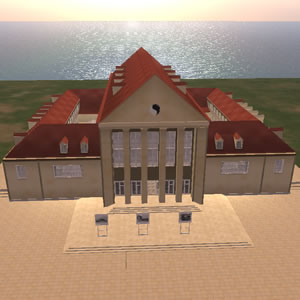The virtual theatres
Hellerau Festspielhaus, Hellerau, Germany

The Festspielhaus at the 'garden city' of Hellerau was constructed, 1911-12, and, until 1914, was the site of extremely important experimental work. An institute for the study of 'rhythmic gymnastics' or 'eurhythmics' led by Emile Jaques Dalcroze was established here. Under the guidance of the great theatre designer and theoretician, Adolphe Appia, extraordinarily innovative work in movement, lighting, and the creation and use of stage settings was carried out, in the context of the investigation and development of entirely new types of performance. This work, publicised internationally by public festivals held at the institute in 1912 and 1913, had a decisive influence upon the subsequent evolution of scene design, lighting, modern dance and indeed upon the entire concept of the nature and limits of theatrical art. It marks the birth of the modern theatre.
Eighty years after its construction, and following its occupation by a Soviet garrison after World War Two, the building was in a severely delapidated condition. Note that the original yin-yang symbol had been replaced by that of the Red Star.
Under the direction of the European Workshop for Art and Culture, Hellerau, and with the financial assistance of the J. Paul Getty Trust, and other organisations, a programme of extensive conservation and renovation work began. As far as possible, all of the architecural and decorative details are being restored to their original condition.